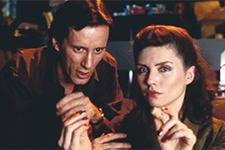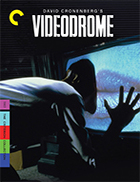Videodrome (4K UHD)
|  Writer/director David Cronenberg may be many things, but above all he is ambitious—wildly, exhilarating, sometimes frustratingly ambitious. Throughout the 1970s and 1980s, he built his career on a series of horror and science fiction thrillers that many tried to dismiss because they were gory and often borderline repulsive. Yet, that goriness is central to the philosophical and ideological obsessions that elevate his films above their B-movie premises. His fascination with the details of corporeality and reintegrating the Cartesian mind/body split led to such intriguing films as Shivers (1975), about fecal-like parasites that turn the placid denizens of a modernist apartment building into sexually ravenous zombies, and Rabid (1977), in which he cast infamous porn star Marilyn Chambers as a woman whose plastic surgery operation following a motorcycle accident turns her into a bloodthirsty, though guilt-stricken, vampire. As sensational and gruesome as they are, as even a cursory examination shows that they are artful products of a fervid and probing imagination, packed to the hilt with underlying metaphors and social messages that give weight to what would be, in lesser hands, forgettable. By the early 1980s, Cronenberg had made a name for himself in the industry and was considered one of the most promising sci-fi/horror auteurs. Thus, he embarked on what would be one of his most ambitious films to date, Videodrome, a twisted cautionary tale masquerading as a conspiracy thriller. Here, he attempted to meld not only his fascination with the connection between the body and the mind, but also with technology, namely then-nascent video technology. Despite getting deeply convoluted by the third act, probably the result of having to start production without a finished script, Videodrome successfully makes graphic the idea of the dwindling nature of human existence in a technologically driven modern society in which the human consciousness is quickly being replaced by global media. The main target in Videodrome is television and video, the latter of which was evolving into a major force when the movie was made. Cronenberg attempts to make the point that the sickness in our heads is both created and amplified by what we watch on-screen. Yet, the mediated world is, if not a reflection, at least a product of the human mind, thus closing the circle and eliminating any possibility of determining simple A-to-B causality. The only thing we can gather for sure is that humanity created media, but media are absorbing humanity, making the two impossible to separate. Cronenberg, working with special effects maestro Rick Baker, who had just won the first make-up effects Oscar for his work on An American Werewolf in London (1981), makes this shockingly literal with such images as a television set that ripples and breathes like human flesh and a character who has pulsating videotapes inserted into a vagina-like wound in his torso. On a more subtle note, the difference between the real and the mediated is blurred with a character who literally exists only on videotape, yet is perceived as being just as “real” as anyone else. The protagonist is Max Renn (James Woods), the opportunistic producer of Civic-TV, a small cable station that attempts to separate itself from the pack by programming graphic violence and soft-core sex features—basically the stuff no one else will show. Early in the film, he is invited onto a TV talk show, where he is forced to defend his programming practices from accusations of how they influence and even cause real-life violence. When questioned about the effects of violence on television, Renn simply replies, “Better on TV than on the streets,” an off-handed quip that is more practiced sound bite than internalized ideology. Renn is not a crusader in any way; he is just out to make a buck. Yet, his statement turns out to be ironic because what Videodrome eventually shows is that there is little difference between what is on the street and what is on the tube. Renn is fooling himself into believing that the visuals we digest have no effect on us or vice-versa. In an early scene, he and his two partners are watching a new soft-core sex movie he purchased at a seedy motel from some Asian film producers. Renn, obviously bored with the soft lighting and sensual movements, says, “I want something that will break through. Something tough.” This is exactly what he gets when his video pirate, a bespectacled techno geek named Harlan (Peter Dvorsky), accidentally picks up a mysterious broadcast. The show, which Renn later discovers is called “Videodrome” and is filmed in Pittsburgh, is nothing more than graphic torture and murder in a single room with one camera. While Renn thinks it is all great acting and special effects—exactly the kind of “tough” programming he is looking for—there is the suggestion that it is, in fact, the real deal: a snuff film where people actually die before the camera. Renn, ever the cynic, doesn’t (or doesn’t want to) believe that the violence might be real, and instead fills himself up with the prospect that this is “the next big thing” (one is forced to wonder, of course, what could possibly top it later on). His girlfriend, Nicki (Deborah Harry), a radio psychiatrist who he met on the talk show, seems to think it is the next big thing, as well. But, then again, she is a masochist who likes to have her ear pierced with a pin during sex and burns her own breast with a cigarette. It turns out that “Videodrome” is much more than just snuff films. When Renn begins hallucinating after watching the program, he seeks out a Marshall McLuhan-esque media guru named Brian O’Blivion (Jack Creley) who may be behind it all. Eventually, we discern that there is little difference between what is going on in Renn’s mind and what is his reality. In fact, as he uncovers a vast conspiracy surrounding the true purpose of the “Videodrome” signal, his mind becomes his mediated reality; he literally turns into McLuhan’s “media landscape.” Soon, Renn has been turned into a programmed assassin and is screaming, “Long live the new flesh!,” the metaphorical implications of which clearly reflect Cronenberg’s melding of the mind, the body, and video, although what it all means is left decidedly ambiguous. Cronenberg has been accused in the past of being a deeply reactionary filmmaker whose body-horror films are meant to make us fear and loathe our own flesh. But, Videodrome seems to suggest that it is the nefarious potential of technology that we should truly fear. In this case, the medium truly is the message.
Copyright © 2023 James Kendrick Thoughts? E-mail James Kendrick All images copyright © The Criterion Collection | |||||||||||||||||||||||||||||
Overall Rating: 

 (3)
(3)


